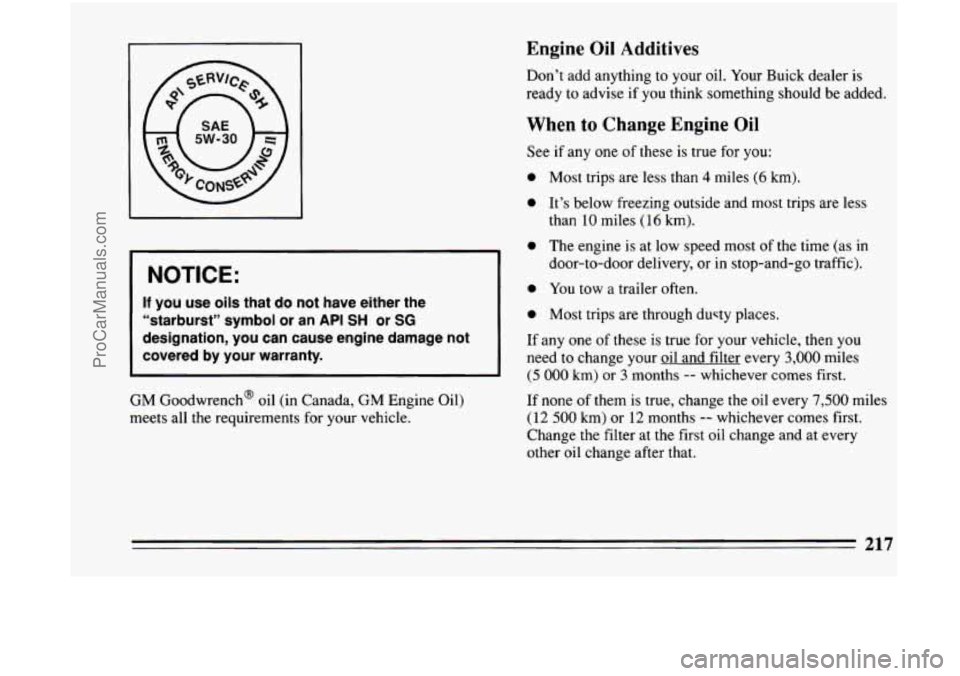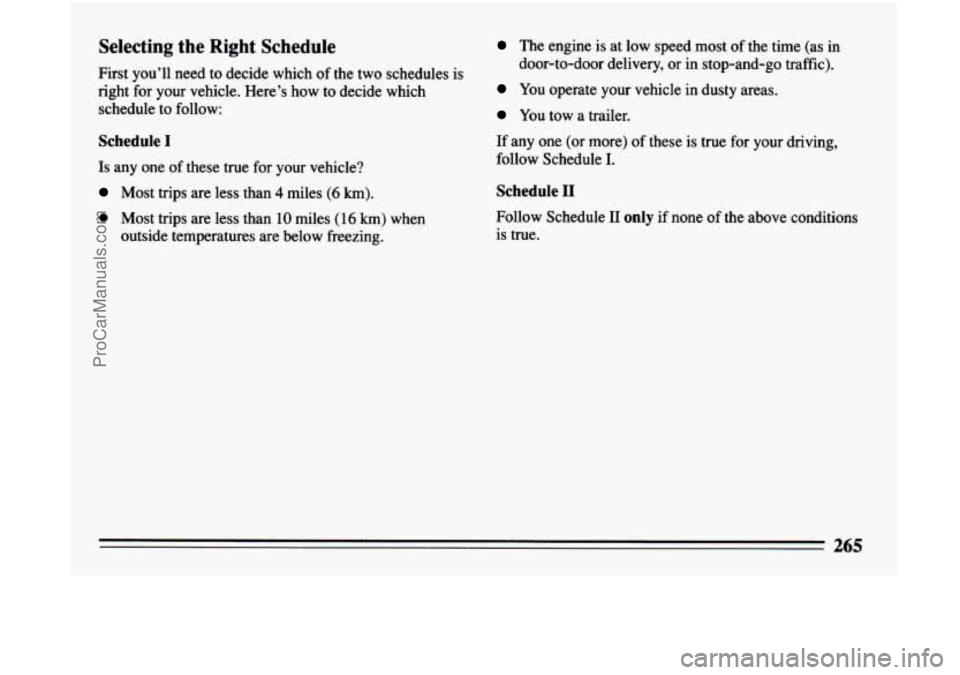1994 BUICK CENTURY trailer
[x] Cancel search: trailerPage 171 of 308

Passing
You’ll need more passing distance up ahead when
you’re towing a trailer. And, because you’re a good deal
longer, you’ll need to go much farther beyond the
passed vehicle before you can return to
your lane.
Backing Up
Hold the bottom of the steering wheel with one hand.
Then, to move the trailer to the left, just move that hand
to the left.
To move the trailer to the right, move your
hand to the right. Always back up slowly and,
if
possible, have someone guide you.
Making Turns
When you’re turning with a trailer, make wider turns
than normal.
Do this so your trailer won’t strike soft
shoulders, curbs, road signs, trees, or other objects.
Avoid jerky
or sudden maneuvers. Signal well in
advance.
Turn Signals When Towing a Trailer
When you tow a trailer, your vehicle has to have a
different turn signal flasher and extra wiring. The green arrows
on your instrument panel
will flash whenever
you signal
a turn or lane change. Properly hooked up,
the trailer lights
will also flash, telling other drivers
you’re about to turn, change lanes or stop.
When towing a trailer, the green arrows on your
instrument panel
will flash for turns even if the bulbs on
the trailer are burned out. Thus, you may
think drivers
behind you are seeing your signal when they are not. It’s
important to check occasionally to be sure
the trailer
bulbs are still working.
Driving On Grades
Reduce speed and shift to a lower gear before you start
down a long or steep downgrade.
If you don’t shift
down, you might have
to use your brakes so much that
they would get hot and no longer work well.
On a long
uphill grade, shift down and reduce your
speed to around 45
mph (70 km/h) to reduce the
possibility
of engine and transaxle overheating.
If you are towing a trailer that weighs more than 1,000
pounds (450
kg) and you have an automatic transaxle
with Overdrive, you may prefer to drive in “D” instead
of Overdrive.
An overdrive transmission is required if
towing a trailer more than 1,000 pounds (450 kg).
ProCarManuals.com
Page 172 of 308

Parking on Hills
You really should not park your vehicle, with a trailer
attached, on
a hill. If something goes wrong, your rig
could
start to move. People can be injured, and both
your,vehicle and the trailer can be damaged.
But if
you ever have to park your rig on a hill, here’s
how to do it:
1. Apply your regular brakes, but don’t shift into
“P”
(Park) yet.
2. Have someone place chocks under the trailer wheels.
3. When the wheel chocks are in place, release the
regular brakes until the chocks absorb
the load.
4. Reapply the regular brakes. Then, apply your
parking brake, and then shift to
“P” (Park).
5. Release the regular brakes.
When You Are Ready to Leave After
Parking on a Hill
1. Apply your regular brakes and hold the pedal down
while you:
Start your engine;
Shift into a gear; and
Release the parking brake.
2. Let up on the brake pedal.
3. Drive slowly until the trailer is clear of the chocks.
4. Stop and have someone pick up and store the chocks.
Maintenance When Trailer Towing
Your vehicle will need service more often when you’re
pulling a trailer. See the Maintenance Schedule for more
on this. Things that are especially important in trailer
operation are automatic transaxle fluid (don’t overfill),
engine oil, belt, cooling system, and brake adjustment.
Each of these
is covered in this manual, and the Index
will help
you find them quickly. If you’re trailering, it’s
a good idea to review these sections before you start
your trip.
Check periodically to see that all hitch nuts and bolts are
tight.
170
ProCarManuals.com
Page 186 of 308

Engine Overheating
You will find a coolant temperature gage or the warning
light about a hot engine on
your Buick’s instrument
panel.
If Steam Is Coming From Your Engine
I NOTICE:
If your engine catches fire because you keep
driving with no coolant, your vehicle can be
badly damaged. The costly repairs would not be
covered by your warranty.
If No Steam Is Coming From Your Engine
If you get the overheat warning but see or hear no
steam, the problem may not be too serious. Sometimes
the engine can get a little too hot when
you:
Climb a long hill on a hot day.
Stop after high speed driving.
Idle for long periods in traffic.
Tow a trailer.
184
ProCarManuals.com
Page 219 of 308

NOTICE:
If you use oils that do not have either the
“starburst” symbol or an
API SH or SG
designation, you can cause engine damage not
covered by your warranty.
GM Goodwrench@ oil (in Canada, GM Engine Oil)
meets all the requirements for your vehicle.
Engine Oil Additives
Don’t add anything to your oil. Your Buick dealer is
ready to advise if you think something should be added.
When to Change Engine Oil
See if any one of these is true for you:
0 Most trips are less than 4 miles (6 km).
0 It’s below freezing outside and most trips are less
0 The engine is at low speed most of the time (as in
0 You tow a trailer often.
0 Most trips are through dwty places.
If any one of these is true for your vehicle, then you
need to change your oil and filter every
3,000 miles
(5 000 km) or 3 months -- whichever comes first.
If none
of them is true, change the oil every 7,500 miles
(12 500 km) or 12 months -- whichever comes first.
Change the filter at the first oil change and at every
other oil change after that.
than
10 miles (1 6 km).
door-to-door delivery,
or in stop-and-go traffic).
217
ProCarManuals.com
Page 223 of 308

Wait at least 30 minutes before checking the transaxle
fluid level if you have been driving:
0 When outside temperatures are above 90°F (32°C).
0 At high speed for quite a while.
0 In heavy traffic -- especially in hot weather.
0 While pulling a trailer.
To get the right reading, the fluid should be at normal
operating temperature, which is 180°F to
200°F (82°C
to
93°C).
Get the vehicle warmed up by driving about 15 miles
(24 km) when outside temperatures are above 50°F
(10°C). If it’s colder than 50°F ( 10°C), you may have
to drive longer.
To check the fluid level
0 Park your vehicle on a level place and keep the
0 With the parking brake applied, place the shift lever
engine
running.
in “P’ (Park).
0 With your foot on the brake pedal, move the shift
lever through each gear range, pausing for about
three seconds
in each range. Then, position the shift
lever
in “P” (Park).
0 Let the engine run at idle for three to five minutes.
Then, without shutting off the engine. follow these
steps:
221
ProCarManuals.com
Page 267 of 308

Selecting the Right Schedule
First you’ll need to decide which of the two schedules is
right for your vehicle. Here’s how to decide
which
schedule to follow:
Schedule I
Is any one of these true for your vehicle?
Most trips are less than 4 miles (6 km).
0 Most trips are less than 10 miles (16 km) when
outside temperatures are below fi-eezing.
The engine is at low speed most of the time (as in
You operate your vehicle in dusty areas.
You tow a trailer.
door-to-door delivery, or
in stop-and-go traffic).
If any one
(or more) of these is true for your driving,
follow Schedule I.
Schedule I1
Follow Schedule I1 only if none of the above conditions
is true.
ProCarManuals.com
Page 268 of 308

Scheduled Maintenance Services Schedule I
~
Follow Schedule I if your car is MAINLY driven under one or more of the following conditions:
0 When most trips are less than 4 miles (6 kilometers).
0 When most trips are less than 10 miles (16 kilometers) and outside temperatures remain below fr\
eezing.
0 When most trips include extended idling and/or frequent low-spee\
d operation as in stop-and-go traffic.
0 Towing a trailer.*?
0 When operating in dusty areas.
Schedule I should also be followed if the car is used for delivery service, police, taxi or other commercial applications. \
TO BE SERVICED
(See Explanation of
Scheduled Maintenance Miles (kilometers) or
Services Following Months, Whichever
Schedules I and 11) Occurs First KILOMETERS (000)
WHEN TO PERFORM MILES (000)
3
Item No.
Every30oOmi.(50@)km)or months 0 0 0 0 0 0 0 0 0 0 1. Engine oil & Filter Change
5 10 15 20 25 30 35 40 45 50 55 60 65 70 75 80
3. Tire & Wheel Rotation &
Every other oil change 0 0 0 0 0 0 0 0 2. Chassis Lubrication
every 15 ooo mi. (25 ooo km)
At 6 OOO mi. (10 000 km) and
or as necessary
4. Engine Accessory Drive
5. Cooling System Service"
Inspection
0 0 0
Belt(s)
Inspection* Every 30 OOO mi.
(50 000 km) or 24 months. 0
266
ProCarManuals.com
Page 273 of 308

6. ’Ikande Service -- Change both the fluid and filter
every 15,000 miles
(25 0oO km) if the vehicle is
mainly driven under one or more of these conditions:
In heavy city traffic where the outside
temperature regularly reaches
90°F (32 “C) or
higher.
0 In hilly or mountainous terrain.
0 When doing frequent trailer towing.
Uses such as found in taxi, police car or delivery
service.
9. Exhaust Gas Recirculation (EGR) System
Inspection
(2.2 L Code 4 engine only) *? ---
Conduct the EGR system service as described in the
service manual.
To purchase a service manual, see
“Service Publications” in the Index.
10. Air Cleaner Filter Replacement* -- Replace every
30,000 miles (50 0o0 km) or more often under dusty
conditions. Ask your dealer for the proper
replacement intervals for your driving conditions.
11.
Fuel Tank, Cap and Lines Inspection*? -- Inspect
fuel
tank, cap and lines for damage or leaks. Inspect
fuel cap gasket for an even filler neck imprint
or any
damage. Replace parts as needed. Periodic replacement
of the fuel filter is not required.
If you
do not use your vehicle under any of these
conditions, change both the fluid and filter every 100,OOO miles (160 OOO km).
7. Spark Plug Replacement* -- Replace spark plugs
with the proper type. See “Specifications Chart”
in
the Index.
8. Spark Plug Wire Inspection*’f’ -- Inspect for bums,
cracks or other damage. Check the boot fit at the
distributor and at the spark plugs. Replace wires as
needed.
* An Emission Control Service.
The
U.S. Environmental Protection Agency or the California Air Resources Board has determined that the fail\
ure to perform this maintenance item will not nullify the
emission warranty or limit recall liability prior to the completion of vehicle useful life. General Motors, however, urges that all recommended maintenance services be performed at the indicated intervals and the maintenance be recorded in “Section E:Maintenance Record”.
271
ProCarManuals.com